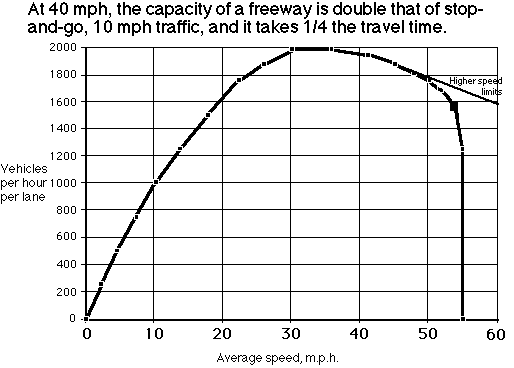June 7, 1999
The Honorable John Burton
Senate President Pro Tempore
P.O. Box 942848
Sacramento, CA 94248-0001
Subject: transportation bonds
Honorable Senator Burton,
Traffic congestion can only be eliminated by using Free Market
principles, and not by using bonds to subsidize more highway lanes
that become just as congested in a few years. Here are nine (9) ways
to do it at very little or no cost. The blue underlined words below
provide more detail on that topic by clicking on it on our web site
by first going to
moderntransit.org/letters/burton.html
1) Implement employee parking cash-out (equalizing the parking subsidy). This would have an immediate impact of reducing car commuting by 25%.
2) Raise the gas tax in a "revenue neutral" manner. At present, about half of local road costs are paid for by property taxes. "Revenue neutral" means all gas tax proceeds would go toward reducing property and sales taxes.
3) Abolish all automobile subsidies (direct and indirect) and pay for this from the gas tax or other auto user fees.
4) Institute HOT (High Occupancy/Toll) lanes on existing lanes of roads, not by adding more lanes.
5) Eliminate all "traffic mitigation fees" and "developer fees" and "parking assessment fees" that subsidize the automobile. Alternatively, use these fees for constructing guideway transit instead of automobile-related construction that encourages greater auto use.
6) Eliminate parking requirements in industrial areas (and ideally, everywhere). If necessary, implement parking permits for neighborhoods (already common in some cities).
7) Implement traffic calming to create a more livable neighborhood and decrease automobile dependency. This will also decrease auto usage.
8) Any congestion still remaining will be eliminated by use of congestion pricing. This means charging for road use an amount that varies so that traffic is kept moving. As rush hour approaches, the price increases in stages in order to keep total cars using the facility at the same optimal flow level. The money raised could be used to build guideway transit because road users also benefit by paying for potential motorists to use alternatives. Congestion pricing also increases highway capacity (see graph, below), while reducing political pressure for more highway construction. [Details]

9) If any new lane or road is constructed, use non-stop toll collection (we call them "road fares") to pay for it. All moneys for the new lane or road needs to be paid for by its direct users and preferably privately financed to guaranty that there would be no government subsidy. The roadway needs to pay the same property tax rate as railroads, to be fair.
Increasing highway capacity increases auto usage, and the same congestion as today returns soon (in as little as two years) after construction. It does not decrease congestion in the long term. This effect is called induced traffic. It is well-documented.
Finally, official government policy is to encourage people to commute by means other than the automobile. Anything subsidized is encouraged. Therefore, we will oppose any further subsidies to the automobile, including a bond proposition. We also oppose lumping highways and transit funding into one proposition. This does not enable the electorate to vote for one and oppose the other.
Sincerely,
Akos Szoboszlay
President